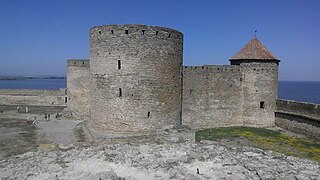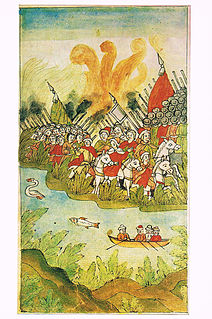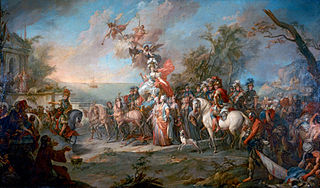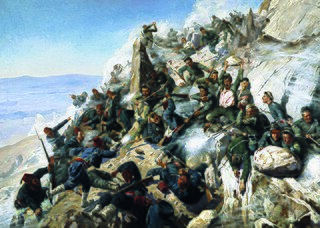 W
WThe Azov campaigns of 1695–96, were two Russian military campaigns during the Russo-Turkish War of 1686–1700, led by Peter the Great and aimed at capturing the Turkish fortress of Azov, which had been blocking Russia's access to the Azov Sea and the Black Sea. Since the Crimean campaigns of 1687 and 1689 had failed because of the difficulty of moving a large army across the steppe, Peter decided to try a river approach.
 W
WThe Azov Fortress is a fortified complex in Azov, Rostov oblast, Russia, overlooking the Don River and the Port of Azov to the north. It includes a rampart, watchtowers and gates. The Azov fortress was founded by Turks on behalf of the Ottoman Empire in 1475. It guarded the northern approaches to the Empire and access to the Azov Sea. After a series of conflicts, a peace treaty was signed in Constantinople on July 13, 1700 between the Tsardom of Russia and the Ottoman Empire. The sultan recognized Russia's possession of the Azov area.
 W
WBilhorod-Dnistrovskyi fortress also known as Akkerman fortress is a historical and architectural monument of the 13th-14th centuries. It is located in Bilhorod-Dnistrovskyi in the Odessa region of southwestern Ukraine, the historical Budjak.
 W
WThe Treaty of Bucharest between the Ottoman Empire and the Russian Empire, was signed on 28 May 1812, in Manuc's Inn in Bucharest, and ratified on 5 July 1812, at the end of the Russo-Turkish War of 1806–12. The Ottomans had done poorly in the war. The Sublime Porte above all wanted to stay out of the impending conflict between Napoleon and Russia. The Russians wanted no side war and thus they made peace in order to be free for the potential war with France. The Ottomans had extricated themselves from a potentially disastrous war with a slight loss of territory. This treaty became the basis for future Russo-Ottoman relations.
 W
WThe Caucasus campaign comprised armed conflicts between the Russian Empire and the Ottoman Empire, later including Armenia, Azerbaijan, Georgia, Mountainous Republic of the Northern Caucasus, the German Empire, the Central Caspian Dictatorship, and the British Empire, as part of the Middle Eastern theatre during World War I. The Caucasus campaign extended from the South Caucasus to the Armenian Highlands region, reaching as far as Trabzon, Bitlis, Mush and Van. The land warfare was accompanied by the Russian navy in the Black Sea Region of the Ottoman Empire.
 W
WThe Crimean campaigns of 1687 and 1689 were two military campaigns of the Tsardom of Russia against the Crimean Khanate. They were a part of the Russo-Turkish War (1686–1700) and Russo-Crimean Wars. These were the first Russian forces to come close to Crimea since 1569. They failed due to poor planning and the practical problem of moving such a large force across the steppe but nonetheless played a key role in halting the Ottoman expansion in Europe. The campaigns came as a surprise for the Ottoman leadership, spoiled its plans to invade Poland and Hungary and forced it to move significant forces from Europe to the east, which greatly helped the League in its struggle against the Ottomans.
 W
WThe Crimean War was a military conflict fought from October 1853 to February 1856 in which Russia lost to an alliance made up of the Ottoman Empire, the United Kingdom, Sardinia and France. The immediate cause of the war involved the rights of Christian minorities in the Holy Land, which was a part of the Ottoman Empire. The French promoted the rights of Roman Catholics, while Russia promoted those of the Eastern Orthodox Church. The longer-term causes involved the decline of the Ottoman Empire and the unwillingness of Britain and France to allow Russia to gain territory and power at the Ottoman Empire's expense. It has widely been noted that the causes, in one case involving an argument over the keys to the Church of the Nativity, revealed a "great confusion of purpose", yet they led to a war noted for its "notoriously incompetent international butchery".
 W
WJohann Martin Reichsgraf von Elmpt was a military officer of the Russian Empire. A German nobleman who entered the Russian service after first serving in France, he went on to command troops in many of the Empire's wars during the reign of Catherine the Great.
 W
WThe Battle of Molodi was one of the key battles of Ivan the Terrible's reign. It was fought near the village of Molodi, 40 miles (64 km) south of Moscow, in July–August 1572 between the 40,000–60,000-strong horde of Devlet I Giray of Crimea and about 23,000–25,000 Russians led by Prince Mikhail Vorotynsky. The Crimeans had burned Moscow the previous year, but this time they were thoroughly defeated.
 W
WThe Russo-Ottoman War of 1710–11, also known as the Pruth River Campaign after the main event of the war, erupted as a consequence of the defeat of Sweden by the Russian Empire in the Battle of Poltava in the summer of 1709 and the escape of the wounded King Charles XII of Sweden and his large retinue to the Ottoman fortress of Bender. Sultan Ahmed III declined incessant Russian demands for Charles's eviction, prompting Tsar Peter I of Russia to attack the Ottoman Empire, which in its turn declared war on Russia on 20 November 1710. Concurrently with these events, the Prince Dimitrie Cantemir of Moldavia and Tsar Peter signed the Treaty of Lutsk, by which Moldavia pledged to support Russia in its war against the Ottomans with troops and by allowing the Russian army to cross its territory and place garrisons in Moldavian fortresses. After having gathered near the Moldavian capital Iași, the combined Russo-Moldavian army started on 11 July the march southwards along the Prut River with the intention of crossing the Danube and invading the Balkan peninsula.
 W
WThe Russian conquest of the Caucasus mainly occurred between 1800 and 1864. In that era the Russian Empire expanded to control the region between the Black Sea and Caspian Sea, the territory that is modern Armenia, Azerbaijan, Georgia, and parts of Iran and Turkey, as well as the North Caucasus region of modern Russia. Multiple wars were fought against the local rulers of the regions, as well as the dominant powers, the Ottoman Empire and Persian Empire, for control. By 1864 the last regions were brought under Russian control.
 W
WThe Russo-Turkish War of 1676–1681, a war between the Tsardom of Russia and Ottoman Empire, caused by Turkish expansionism in the second half of the 17th century.
 W
WThe Russo-Turkish War of 1686–1700 was part of the joint European effort to confront the Ottoman Empire. The larger European conflict was known as the Great Turkish War.
 W
WThe Russo-Turkish War of 1768–1774 was a major armed conflict that saw Russian arms largely victorious against the Ottoman Empire. Russia's victory brought Kabardia, part of Moldavia, the Yedisan between the rivers Bug and Dnieper, and Crimea into the Russian sphere of influence. Though a series of victories accrued by the Russian Empire led to substantial territorial conquests, including direct conquest over much of the Pontic–Caspian steppe, less Ottoman territory was directly annexed than might otherwise be expected due to a complex struggle within the European diplomatic system to maintain a balance of power that was acceptable to other European states and avoided direct Russian hegemony over Eastern Europe.
 W
WThe Russo-Turkish War of 1787–1792 involved an unsuccessful attempt by the Ottoman Empire to regain lands lost to the Russian Empire in the course of the previous Russo-Turkish War (1768–1774). It took place concomitantly with the Austro-Turkish War (1788–1791).
 W
WThe Russo-Turkish War (1806–1812) between the Russian Empire and the Ottoman Empire was one of the Russo-Turkish Wars. Russia prevailed, but both sides wanted peace as they feared Napoleon's moves to the east.
 W
WThe Russo-Turkish War of 1828–1829 was sparked by the Greek War of Independence of 1821–1829. War broke out after the Ottoman Sultan Mahmud II closed the Dardanelles to Russian ships and revoked the 1826 Akkerman Convention in retaliation for Russian participation in October 1827 in the Battle of Navarino.
 W
WThe Russo-Turkish War of 1877–1878 was a conflict between the Ottoman Empire and the Eastern Orthodox coalition led by the Russian Empire and composed of Bulgaria, Romania, Serbia, and Montenegro. Fought in the Balkans and in the Caucasus, it originated in emerging 19th-century Balkan nationalism. Additional factors included Russian goals of recovering territorial losses endured during the Crimean War of 1853–56, re-establishing itself in the Black Sea and supporting the political movement attempting to free Balkan nations from the Ottoman Empire.
 W
WThe Siege of Izmail was a military investment fought in 1790 on the Black Sea during the Russo-Turkish War (1787–1792). The Russians were led by Alexander Suvorov, who had defeated the Ottomans at Kinburn, Ochakov, and Focsani. The Black Sea flotilla was commanded by the Spanish admiral José de Ribas.
 W
WThe Treaty of Adrianople concluded the Russo-Turkish War of 1828–29, between Russia and the Ottoman Empire. The terms favored Russia which gained access to the mouths of the Danube and new territory on the Black Sea. The Treaty opened the Dardanelles to all commercial vessels, granted autonomy to Serbia, and promised autonomy for Greece. It also allowed Russia to occupy Moldavia and Walachia until the Ottoman Empire had paid a large indemnity; those indemnities were later reduced. The Treaty was signed on 14 September 1829 in Adrianople by Count Alexey Fyodorovich Orlov of Russia and by Abdülkadir Bey of the Ottoman Empire.
 W
WThe Treaty of Belgrade, known as the Belgrade peace was the peace treaty signed on September 18, 1739 in Belgrade, Habsburg Kingdom of Serbia, by the Ottoman Empire on one side and the Habsburg Monarchy on the other, that ended the Austro–Turkish War (1737–39).
 W
WThe Treaty of Jassy, signed at Jassy (Iași) in Moldavia, was a pact between the Russian and Ottoman Empires ending the Russo-Turkish War of 1787–92 and confirming Russia's increasing dominance in the Black Sea.
 W
WThe Treaty of Paris of 1856 settled the Crimean War between the Russian Empire and an alliance of the Ottoman Empire, Great Britain, the Second French Empire and the Kingdom of Sardinia.
 W
WThe 1878 Treaty of San Stefano was a treaty between Russia and the Ottoman Empire signed at San Stefano, then a village west of Constantinople, on 3 March [O.S. 19 February] 1878 by Count Nicholas Pavlovich Ignatiev and Aleksandr Nelidov on behalf of the Russian Empire and Foreign Minister Saffet Pasha and Ambassador to Germany Sadullah Bey on behalf of the Ottoman Empire. The treaty ended the Russo-Turkish War, 1877–78.
 W
WWorld War I was a global war originating in Europe that lasted from 28 July 1914 to 11 November 1918. Contemporaneously known as the Great War or "the war to end all wars", it led to the mobilisation of more than 70 million military personnel, including 60 million Europeans, making it one of the largest wars in history. It is also one of the deadliest conflicts in history, with an estimated nine million combatant deaths and 13 million civilian deaths as a direct result of the war, while resulting genocides and the related 1918 Spanish flu pandemic caused another 17–100 million deaths worldwide, including an estimated 2.64 million Spanish flu deaths in Europe and as many as 675,000 Spanish flu deaths in the United States.